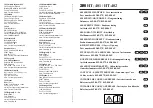
System description
18
The following residual currents flow through the measuring current
transformer of the EDS... :
the test current I(ds) caused by the insulation fault R
F-N
,
residual currents I(d) flowing through the system leakage capacitances
C
E-V,
C
E-N,
R
F-V
and R
F-N
,
transient leakage currents caused by switching and control activities in
the system,
low-frequency leakage currents caused by the use of converters.
3.2.4
Requirements for reliable insulation fault location
The EDS... is intended to detect insulation faults downstream of the
measuring current transformer R
F-N
. For this purpose, the test current
caused by the insulation fault has to be detected reliably, subject to the
condition that:
The test current I(ds) for the EDS460/490 is more than 2 mA and less
than 50 mA.
The test current I(ds) for the EDS461/491 is more than 0.2 mA and less
than 5 mA.
The upstream capacitances C
E-V
must be at least as large as the down-
stream capacitances C
E-N.
The system leakage capacitance does not have to be too large (see
"Response sensitivity characteristics" on page 71).
The total residual current through the measuring current transformer
(test current and residual currents etc.) may be a maximum of 10 A
(EDS460/490) respectively 1 A (EDS461/491).
Not only does the amplitude influence the reliable detection of the test
current but also the residual current frequency. This effect is illustrated
in the following fault curve.
Summary of Contents for EDS460
Page 20: ...System description 20 TGH1394en 05 2007...
Page 87: ......
















































